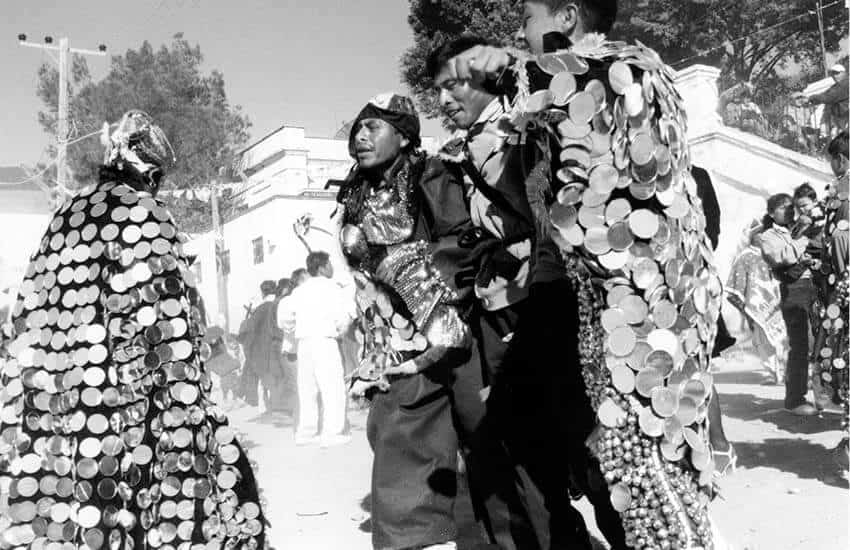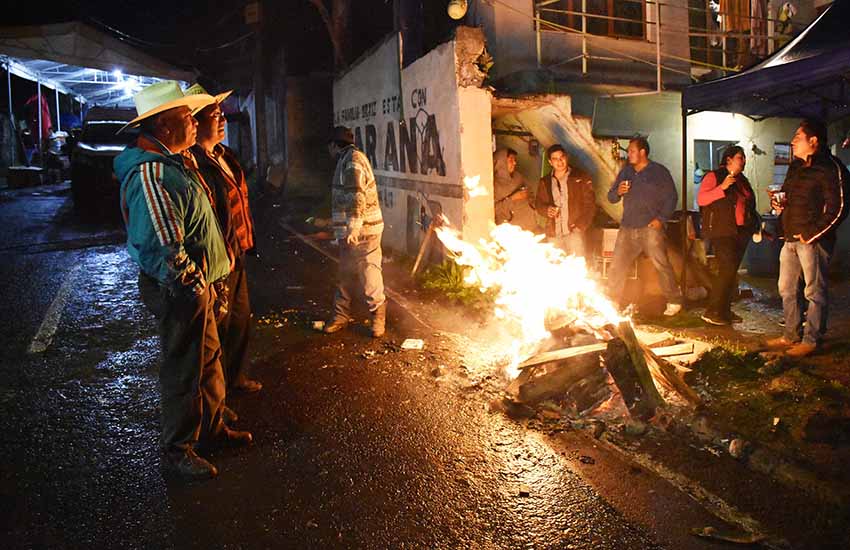I was afraid of graveyards when I was a kid. OK, that’s not completely true. I was, in fact, terrified of them.
Once as a teenager driving around with some friends, I naively mentioned this. The next thing I knew, the driver was pulling into a graveyard. At night. What are friends for, right? I started freaking out and, when I couldn’t get the door open, started pounding on the side window. The driver took the hint and turned around.
I don’t know when I first heard about Day of the Dead, but I was still pretty young and I simply couldn’t fathom why people would willingly spend the night in a graveyard. But as strange as it seemed, there was something intriguing about the ceremony, and when I made my first trip to Mexico in 1997, it was to photograph the holiday.
I ended up in Metepec, México state, with Olivia, a friend of the friend with whom I was staying in Tepoztlán. We arrived at the graveyard at dusk, and it quickly became clear that photographing would be difficult. With no lights as it got dark, it became impossible. I couldn’t see anything. Olivia suggested taking a break and returning in the early morning.
When we drove back there in the pre-dawn darkness, a golden light hovered over the graveyard’s walls. I hurried out of the car, annoyed because I thought I’d missed people building a bonfire. But it wasn’t a bonfire. It was the light from hundreds of small fires and thousands of candles ringing the graves. There was so much light, I was able to see clearly enough to write in my notebook.

On the bus back to Tepoztlán, I struggled to write down my feelings. Although I’d thought I was only there to photograph, something had touched me deeply. I came away feeling as if I’d somehow participated in the ceremony.
I initially wrote, “It was like a religious experience.” As soon as I wrote that, I knew it was wrong. I crossed it out and wrote, “It wasn’t like a religious experience, it was a religious experience.”
My next Day of the Dead wasn’t until 2003, and it wasn’t what I expected. Not at all. I was working on a project documenting the lives of coffee growers in Mexico but made a side trip to San Agustín Etla, a pueblo outside Oaxaca city, to photograph the holiday. I stayed with Fernando, a local artist. Once I’d settled in, I asked, “What do you do for Day of the Dead?”
“Comparsa,” he answered.
“What’s comparsa?” I asked.
“Comparsa is … comparsa.”
I thought it might help if I were more specific, so I asked when we would go to the cemetery.
“We do not go to the cemetery,” was the reply.
“Oh. So what do you do?”
“Comparsa.”
“Comparsa” is the only answer I ever got when I asked about what happened on Day of the Dead in that pueblo, and it was like being in the middle of Abbot and Costello’s “Who’s on First” skit.
Comparsa began at dusk on November 1 with lots of food and drink and a 14-piece band blasting away in someone’s yard. There were many men — and it was only men — in costumes, dancing. Some wore long coats onto which small mirrors had been sewn. One person told me that the mirrors attracted the deceased. Someone else told me that they kept the devil away. I’m not sure which was correct — maybe both.

At some point, the procession began and made its way through the pueblo with the band playing and men dancing. There were stops in front of houses — more food and drink — where skits were put on, mostly about the dead and about dying. Whenever the band started playing, the men started dancing.
The procession continued until about 9 a.m. the next morning. Comparsa had lasted more than 12 hours and I was exhausted just from walking. I asked one man how he could continue dancing after so many hours. He didn’t hesitate to answer.
“Faith,” he said.
Day of the Dead in Santa Ana Tlacotenco, a Mexico City indigenous pueblo in Milpa Alta, is different from what I’d witnessed in other pueblos like Metepec and the Mexico City town of San Gregorio Atlapulco, where people spend the night in a graveyard. People in Santa Ana visit the cemetery during the day. At night, they build fires, called fogatas, in front of their homes.
“Years ago, there was a fire in front of every home,” said José Ortiz Rivera. “Now, not so many. We are losing the tradition.”
I asked several people why they have fogatas and got different answers. One was that it was to bring people together, and I certainly saw that. Another was that the fires guided spirits back to their homes. But the answer I got most often was the one I got from Ortiz.
“It is because when our grandparents return,” he said, “they will be cold. The fires are to warm them.”
I’ve now been in Mexico for four Day of the Dead celebrations. While that certainly doesn’t make me an expert, I have seen enough to clearly recognize the differences in the attitude toward death between the United States and Mexico.
Mexicans seem more accepting — or maybe it’s resigned — to the inevitability of death, and Day of the Dead is a perfect example of that. While most people in the U.S. would try to avoid coming in contact with spirits, Mexicans welcome them, using the petals from cempasúchil (Mexican marigolds) and other brilliantly colored flowers to make paths to guide the spirits back to them.
These paths can be seen outside homes all over the country. The graves and altars in homes have food, drink, cigarettes and other things that the departed liked in life.
In the U.S., death’s a much more somber occasion. I wouldn’t call Day of the Dead festive (unless you go to the Catrina procession or other parades in Mexico City), but there’s music — often small bands traveling from grave to grave, playing music the deceased enjoyed in life. In the graveyards and immediately outside, there’s food and drink and laughter but overall I’d say there’s a melancholy feeling.
Like many things in Mexico, there’s a lot of regional variation on how Day of the Dead is observed. In San Gregorio Atlapulco, November 1 is for remembering children who have died and November 2 is for adults. There are also other days for remembering people who died violently and in accidents. I’ve come to think of it as “Days of the Dead” — or as my friend Karla puts it, “Month of the Dead.”
I’m happy to say I’ve finally overcome my fear of graveyards, and I feel privileged to be able to attend Day of the Dead in Mexico. It’s changed my attitude toward death. I mourn when someone I know dies, but I no longer wrestle with the question, “Why?” Since attending Día de Muertos ceremonies, I see death more clearly as part of the continuum of this thing we call life, and I have come to accept it.
Because, really, what choice do I have?
Joseph Sorrentino, a writer, photographer and author of the book San Gregorio Atlapulco: Cosmvisiones and of Stinky Island Tales: Some Stories from an Italian-American Childhood, is a regular contributor to Mexico News Daily. More examples of his photographs and links to other articles may be found at www.sorrentinophotography.com He currently lives in Chipilo, Puebla.
